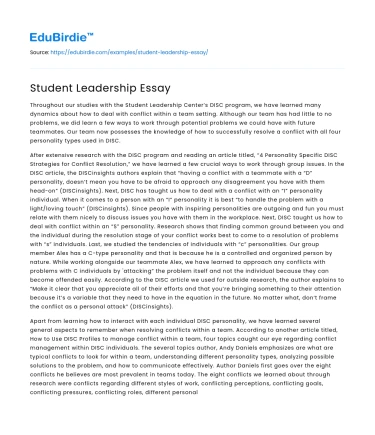Throughout our studies with the Student Leadership Center’s DISC program, we have learned many dynamics about how to deal with conflict within a team setting. Although our team has had little to no problems, we did learn a few ways to work through potential problems we could have with future teammates. Our team now possesses the knowledge of how to successfully resolve a conflict with all four personality types used in DISC.
After extensive research with the DISC program and reading an article titled, “4 Personality Specific DISC Strategies for Conflict Resolution,” we have learned a few crucial ways to work through group issues. In the DISC article, the DISCinsights authors explain that “having a conflict with a teammate with a “D” personality, doesn’t mean you have to be afraid to approach any disagreement you have with them head-on” (DISCinsights). Next, DISC has taught us how to deal with a conflict with an “I” personality individual. When it comes to a person with an “I” personality it is best “to handle the problem with a light/loving touch” (DISCinsights). Since people with inspiring personalities are outgoing and fun you must relate with them nicely to discuss issues you have with them in the workplace. Next, DISC taught us how to deal with conflict within an “S” personality. Research shows that finding common ground between you and the individual during the resolution stage of your conflict works best to come to a resolution of problems with “s” individuals. Last, we studied the tendencies of individuals with “c” personalities. Our group member Alex has a C-type personality and that is because he is a controlled and organized person by nature. While working alongside our teammate Alex, we have learned to approach any conflicts with problems with C individuals by 'attacking” the problem itself and not the individual because they can become offended easily. According to the DISC article we used for outside research, the author explains to “Make it clear that you appreciate all of their efforts and that you’re bringing something to their attention because it’s a variable that they need to have in the equation in the future. No matter what, don’t frame the conflict as a personal attack” (DISCinsights).
Save your time!
We can take care of your essay
- Proper editing and formatting
- Free revision, title page, and bibliography
- Flexible prices and money-back guarantee
Apart from learning how to interact with each individual DISC personality, we have learned several general aspects to remember when resolving conflicts within a team. According to another article titled, How to Use DISC Profiles to manage conflict within a team, four topics caught our eye regarding conflict management within DISC individuals. The several topics author, Andy Daniels emphasizes are what are typical conflicts to look for within a team, understanding different personality types, analyzing possible solutions to the problem, and how to communicate effectively. Author Daniels first goes over the eight conflicts he believes are most prevalent in teams today. The eight conflicts we learned about through research were conflicts regarding different styles of work, conflicting perceptions, conflicting goals, conflicting pressures, conflicting roles, different personal values, and unpredictable worker policies. Next, we learned how to use DISC profiles to understand different personalities. The author taught us tendencies to look for in the four different personalities. He explains that “D personalities usually show signs of being more drive, I personalities are more imaginative than others, S personalities are more sympathetic toward teammates, and C personalities are very cautious” (Daniels). Next, we learned that there isn’t one solution to every problem due to the different personality types we run into each day and each conflict needs to be decided with the individual's DISC profile in mind. Last but not least, author Andy Daniels taught us about how important it is to note that every DISC style has its preferred way of communicating and a conflict resolution discussion should reflect their preferred style.
Through learning from the Student Leadership Center and doing outside research our group has been able to learn many clues to look for to determine if we have a problem in our group and how to resolve them. Although our group had little to no conflicts this semester, we did learn many things from and about DISC and about the conflict in group dynamics to help our group work through any problems, issues, or concerns we might have in teams we are in soon.






 Stuck on your essay?
Stuck on your essay?

